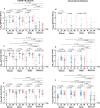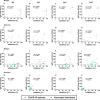Dynamics of Different Classes and Subclasses of Antibody Responses to Severe Acute Respiratory Syndrome Coronavirus 2 Variants after Coronavirus Disease 2019 and CoronaVac Vaccination in Thailand
- PMID: 36688637
- PMCID: PMC9942573
- DOI: 10.1128/msphere.00465-22
Dynamics of Different Classes and Subclasses of Antibody Responses to Severe Acute Respiratory Syndrome Coronavirus 2 Variants after Coronavirus Disease 2019 and CoronaVac Vaccination in Thailand
Abstract
The humoral immune response plays a key role in protecting the population from SARS-CoV-2 transmission. Patients who recovered from COVID-19 as well as fully vaccinated individuals have elevated levels of antibodies. The dynamic levels of the classes and subclasses of antibody responses to new variants that occur in different populations remain unclear. We prospectively recruited 60 participants, including COVID-19 patients and CoronaVac-vaccinated individuals, in Thailand from May to August 2021. Plasma samples were collected on day 0, day 14, and day 28 to determine the dynamic levels of the classes and subclasses of plasma antibodies against the receptor-binding domain (RBD) in the spike protein (S) of four SARS-CoV-2 strains (Wuhan, Alpha, Delta, and Omicron) via enzyme-linked immunosorbent assay. Our results indicated that the patients with SARS-CoV-2 infections had broader class and subclass profiles as well as higher levels of anti-S RBD antibodies to the Wuhan, Alpha, and Delta strains than did the CoronaVac-vaccinated individuals. The median antibody levels increased and subsequently declined in a month in the COVID-19 patients and in the vaccinated group. Correlations of the classes and subclasses of antibodies were observed in the COVID-19 patients but not in the vaccinated individuals. The levels of all of the anti-S RBD antibodies against the Omicron variant were low in the patients and in the vaccinated individuals. Our study revealed distinct antibody profiles between the two cohorts, suggesting different pathways of immune activation. This could have an impact on protection from infections by new variants of concern (VOC). IMPORTANCE The antibody responses to new SARS-CoV-2 variants that occur in different populations remain unclear. In this study, we recruited 60 participants, including COVID-19 patients and CoronaVac-vaccinated individuals, in Thailand and determined the dynamic levels of the IgG, IgA, IgM, and IgG subclasses of antibodies against the spike protein (S) of four SARS-CoV-2 strains. Our results showed that the patients with SARS-CoV-2 infections had broader profiles and higher levels of antibodies to the Wuhan, Alpha, and Delta strains than did the CoronaVac-vaccinated individuals. The antibody levels of both groups increased and subsequently decreased within 1 month. Higher and functional correlations of these antibodies were observed in the COVID-19 patients. The levels of all anti-S RBD antibodies against the Omicron variant were low in patients and vaccinated individuals. Our study revealed distinct antibody responses between the two groups, suggesting different pathways of immune response, which may have an impact on protection from infections by new SARS-CoV-2 variants.
Keywords: COVID-19; IgA; IgG; IgM; SARS-CoV-2; antibodies; antibody; coronavirus variants; plasma antibody; vaccine; vaccines.
Conflict of interest statement
The authors declare no conflict of interest.
Figures







Similar articles
-
Temporal correlations between RBD-ACE2 blocking and binding antibodies to SARS-CoV-2 variants in CoronaVac-vaccinated individuals and their persistence in COVID-19 patients.Sci Rep. 2025 May 6;15(1):15831. doi: 10.1038/s41598-025-98627-3. Sci Rep. 2025. PMID: 40328892 Free PMC article.
-
Emerging Variants of SARS-CoV-2 and Novel Therapeutics Against Coronavirus (COVID-19).2023 May 8. In: StatPearls [Internet]. Treasure Island (FL): StatPearls Publishing; 2025 Jan–. 2023 May 8. In: StatPearls [Internet]. Treasure Island (FL): StatPearls Publishing; 2025 Jan–. PMID: 34033342 Free Books & Documents.
-
Longitudinal analysis to characterize classes and subclasses of antibody responses to recombinant receptor-binding protein (RBD) of SARS-CoV-2 in COVID-19 patients in Thailand.PLoS One. 2021 Aug 10;16(8):e0255796. doi: 10.1371/journal.pone.0255796. eCollection 2021. PLoS One. 2021. PMID: 34375345 Free PMC article.
-
Recognition of Variants of Concern by Antibodies and T Cells Induced by a SARS-CoV-2 Inactivated Vaccine.Front Immunol. 2021 Nov 9;12:747830. doi: 10.3389/fimmu.2021.747830. eCollection 2021. Front Immunol. 2021. PMID: 34858404 Free PMC article. Clinical Trial.
-
The role and uses of antibodies in COVID-19 infections: a living review.Oxf Open Immunol. 2021 Jan 28;2(1):iqab003. doi: 10.1093/oxfimm/iqab003. eCollection 2021. Oxf Open Immunol. 2021. PMID: 34192270 Free PMC article. Review.
Cited by
-
Immunosuppressive Therapy Modifies Anti-Spike IgG Subclasses Distribution After Four Doses of mRNA Vaccination in a Cohort of Kidney Transplant Recipients.Vaccines (Basel). 2025 Jan 25;13(2):123. doi: 10.3390/vaccines13020123. Vaccines (Basel). 2025. PMID: 40006670 Free PMC article.
-
Patterns and functional consequences of antibody speciation in maternal-fetal transfer of coronavirus-specific humoral immunity.PLoS Pathog. 2025 Aug 6;21(8):e1013408. doi: 10.1371/journal.ppat.1013408. eCollection 2025 Aug. PLoS Pathog. 2025. PMID: 40768518 Free PMC article.
-
Comparison of Kinetics of Antibody Avidity and IgG Subclasses' Response in Patients with COVID-19 and Healthy Individuals Vaccinated with the BNT162B2 (Comirnaty, Pfizer/BioNTech) mRNA Vaccine.Viruses. 2023 Apr 14;15(4):970. doi: 10.3390/v15040970. Viruses. 2023. PMID: 37112950 Free PMC article.
-
Non-neutralizing functions in anti-SARS-CoV-2 IgG antibodies.Biomed J. 2024 Feb;47(1):100666. doi: 10.1016/j.bj.2023.100666. Epub 2023 Sep 29. Biomed J. 2024. PMID: 37778697 Free PMC article. Review.
-
Associations between clinical data, vaccination status, antibody responses, and post-COVID-19 symptoms in Thais infected with SARS-CoV-2 Delta and Omicron variants: a 1-year follow-up study.BMC Infect Dis. 2024 Oct 7;24(1):1116. doi: 10.1186/s12879-024-09999-2. BMC Infect Dis. 2024. PMID: 39375604 Free PMC article.
References
-
- Harvey WT, Carabelli AM, Jackson B, Gupta RK, Thomson EC, Harrison EM, Ludden C, Reeve R, Rambaut A, Peacock SJ, Robertson DL. COVID-19 Genomics UK (COG-UK) Consortium. 2021. Sars-Cov-2 variants, spike mutations and immune escape. Nat Rev Microbiol 19:409–424. doi:10.1038/s41579-021-00573-0. - DOI - PMC - PubMed
-
- Alkhatib M, Svicher V, Salpini R, Ambrosio FA, Bellocchi MC, Carioti L, Piermatteo L, Scutari R, Costa G, Artese A, Alcaro S, Shafer R, Ceccherini-Silberstein F. 2021. Sars-Cov-2 variants and their relevant mutational profiles: update summer 2021. Microbiol Spectr 9:e0109621. doi:10.1128/Spectrum.01096-21. - DOI - PMC - PubMed
Publication types
MeSH terms
Substances
Supplementary concepts
Grants and funding
LinkOut - more resources
Full Text Sources
Medical
Miscellaneous

